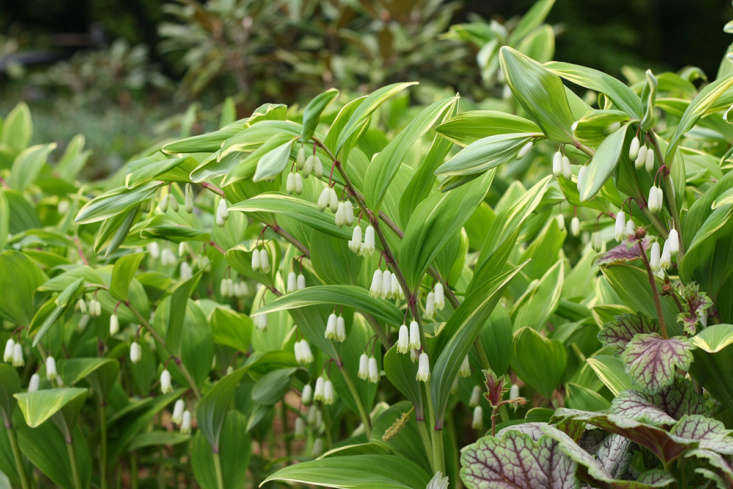Solomon’s Seal, Polygonatum: “Shady Savior”
As a garden designer, I am often asked to recommend plants that are foolproof, black-thumb proof, and low-maintenance. As well as beautiful, of course! A constructive conversation about real-life plant care usually follows. But if the garden under discussion happens to enjoy shade (often seen as a curse), there is a perennial that comes to the rescue, every time: Solomon’s seal checks all those boxes. Polygonatum is a shining shade garden star.
Continue reading to learn how to grow Solomon’s seal, and what you can expect in return.
Photography by Marie Viljoen unless otherwise noted.

With species native to several continents, including North America, the various varieties and cultivars of the Polygonatum genus have in common their distinctively arching stems and delicately pendulous spring flowers. They add an effortless and graceful structure to gardens, as well as significant seasonal variation and interest.

The first shoots appear in early spring, growing from the substantial rhizomes that have overwintered beneath the soil. Over time Solomon’s seal can form dense, textural colonies. After they are established, it is a good idea to divide the clumps every few years to control their spread.

Several weeks later the stalks have grown lush and thigh high. Ivory flowers, frilled with a flared green skirt, hang delicately in scented bells from the bowed stems. They persist for weeks. The blooms are irresistible to early spring bees.

Unlike many spring flowering plants, which begin to look peaky as summer progresses, Solomon’s seal remains handsome all season long, its stalks firm, its leaves perfect. Cut the stems to add to garden bouquets all year long.

Variegated Solomon’s seal is of Asian origin. Polygonatum odoratum f. variegatum is a long mouthful for the elegant plant, whose white-streaked leaves brighten shady corners.

There is even a tiny form of Solomon’s seal for petite gardens, rock gardens, or for the very front of beds: Polygonatum humile tops out at about eight inches and its stems are more upright than its tall cousins’.

In autumn the leaves of Solomon’s seal turn a vivid and saturated yellow, shading fat purple fruit, and adding unexpected perennial color to the chilling garden.

Cheat Sheet
- If you are patient, grow Solomon’s seal from seed; it will take about three years for your new plants to bloom.
- Better yet, ask friends for a few rhizomes from their established colony and plant them in fall.
- Want a pretty filler for your early season summer rolls? Solomon’s seal flowers are edible.

Keep It Alive
- Grow Solomon’s seal in semi, dappled, or high shade. It will not thrive in the deep shade of low-branched trees or urban alleyways.
- Solomon’s seal can take morning or late afternoon sun, but midday sun will scorch and crisp its leaves.
- Water Solomon’s seal well until established, after which the plants are relatively drought tolerant.
- To prevent overcrowding, divide established clumps with a sharp-bladed shovel in late fall (you can snack on slices of the crisp tubers).

See more growing and care tips at Solomon’s Seal: A Field Guide to Planting, Care & Design. And see more of our favorite woodland plants for dappled shade in our curated guides to Perennials 101 and Ground Covers 101, including Lungwort, Hellebores, and Lady’s Mantle. See more of our favorite woodland gardens:
- Lady in Red: A Woodland Chicken Coop with Charm to Spare
- Walk on the Wild Side: A New England Woodland Garden
- 10 Shade Garden Ideas to Steal from an English Woodland









Have a Question or Comment About This Post?
Join the conversation